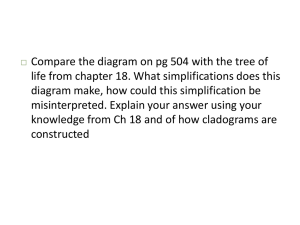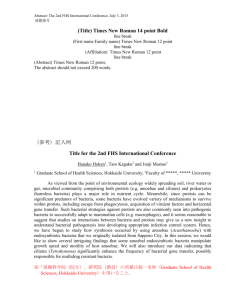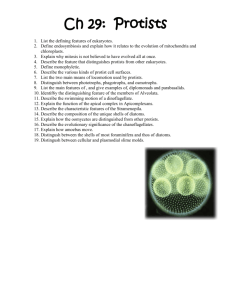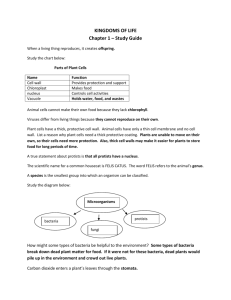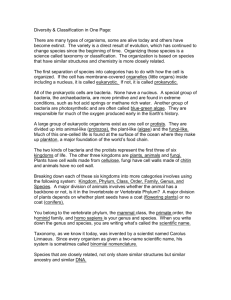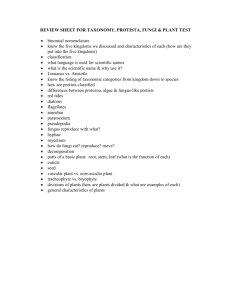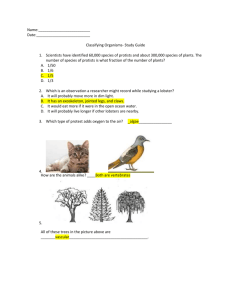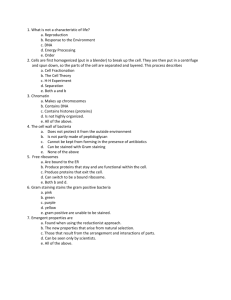Cell Adaptations and Unicellular Organisms
advertisement
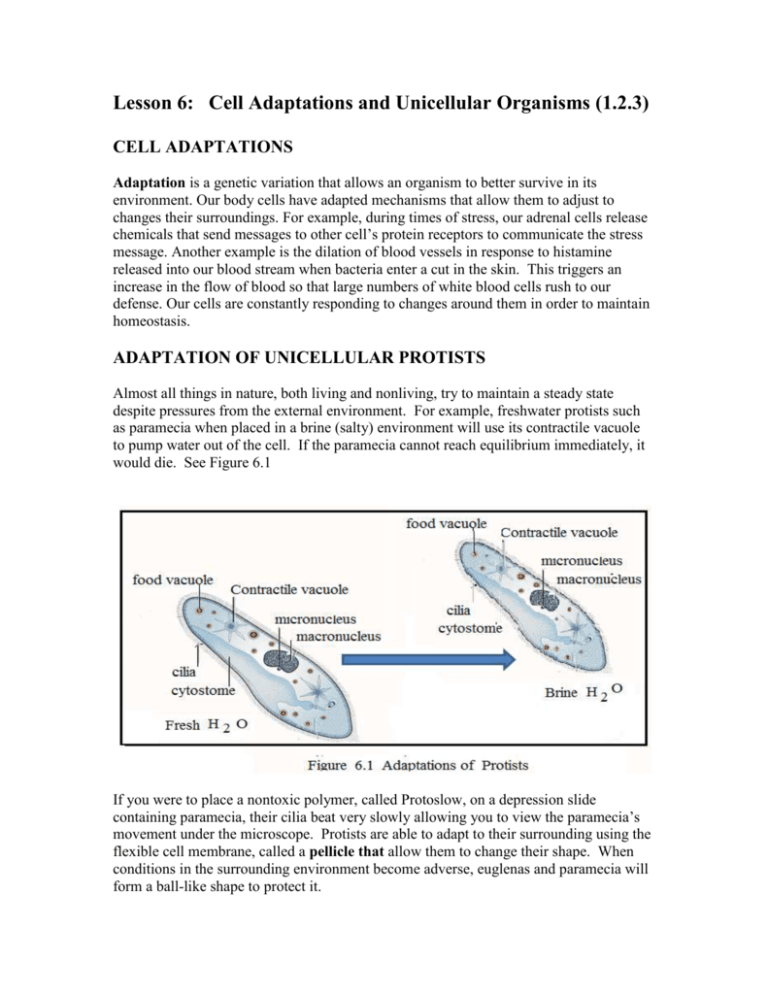
Lesson 6: Cell Adaptations and Unicellular Organisms (1.2.3) CELL ADAPTATIONS Adaptation is a genetic variation that allows an organism to better survive in its environment. Our body cells have adapted mechanisms that allow them to adjust to changes their surroundings. For example, during times of stress, our adrenal cells release chemicals that send messages to other cell’s protein receptors to communicate the stress message. Another example is the dilation of blood vessels in response to histamine released into our blood stream when bacteria enter a cut in the skin. This triggers an increase in the flow of blood so that large numbers of white blood cells rush to our defense. Our cells are constantly responding to changes around them in order to maintain homeostasis. ADAPTATION OF UNICELLULAR PROTISTS Almost all things in nature, both living and nonliving, try to maintain a steady state despite pressures from the external environment. For example, freshwater protists such as paramecia when placed in a brine (salty) environment will use its contractile vacuole to pump water out of the cell. If the paramecia cannot reach equilibrium immediately, it would die. See Figure 6.1 If you were to place a nontoxic polymer, called Protoslow, on a depression slide containing paramecia, their cilia beat very slowly allowing you to view the paramecia’s movement under the microscope. Protists are able to adapt to their surrounding using the flexible cell membrane, called a pellicle that allow them to change their shape. When conditions in the surrounding environment become adverse, euglenas and paramecia will form a ball-like shape to protect it. Activity Select one of the activities below. 1. Watch a video on euglenas and describe in writing how these organisms gather food. http://www.youtube.com/watch?v=J3sgoy22Ij4&NR=1 2. Obtain protoslow from your teacher and a depressions slide and cover slip. Place one drop of water containing Euglenas on the slide, then add one small drop of Protoslow. Observe the live Euglena under 10X and describe its movement. 3. How does the view under 10x compare to the video you saw. Offer an explanation for the differences. Protists respond to chemicals in the water by moving away. This behavior is called negative chemotaxis. Sometimes these organisms cannot adapt to the sudden changes in the environment which leads to death of the organism. Euglenas are freshwater protists that have eyespots which can detect light but not images. Notice how Euglenas congregate in moderate light; however, these protists move away from the extremely bright light. This behavior is known as negative phototaxis. ADAPTATIONS OF PROKARYOTES Prokaryotes successfully live in fresh water or marine environments. They may also be found in environments whose conditions are salty, extremely cold, very hot or very acidic. Prokaryotes are microscopic and have an astonishing genetic diversity. There are more prokaryotes found in a handful of soil than the number of people that ever lived on Earth. Prokaryotes are used in mining, vitamin synthesis, antibiotics and hormones. Some have adaptations that allow them to live in unwanted places in our environment such as canned foods and raw meat. Salmonella is an example in raw meat that causes food poisoning. Some bacteria cells respond to extreme conditions by forming endospores. Endospores are dried out cells (that are still alive) and can live for hundreds of years until they find the right conditions to thrive. Endospores allow prokaryotes to survive in harsh environments, such as very hot and dried out places. Bacteria have a small ring of DNA called a plasmid that carries drug resistant genes. The cell wall maintains the shape of the cell, as well as aiding its defense against foreign cells or substances. Structures within the cell wall and its composition determine the function of prokaryotic cell walls. The cell wall maintains the shape of the cell, as well as aiding its defense against foreign cells or substances. Bacteria can release chemicals into the environment in order to change their environment. Exotoxins are toxins secreted by a prokaryote, such as the toxin released by Vibrio cholerae, the bacteria that causes cholera. Endotoxins are toxins that are released as the prokaryote dies and breaks apart. Salmonella is an example of an endotoxin. The cell walls are composed of peptidoglycan. Gram negative bacteria have a thin layer of peptidoglycan surrounded by a plasma membrane on one side, and an outer membrane on the outside. Gram positive bacteria have no outer layer, and a much larger amount of peptidoglycan. Differences in the cell wall are why antibiotics kill bacteria and no other cells in the body. This is why antibiotics will not cure viral diseases. Activity Research why antibiotics will not treat and help you get over the common cold. PROTIST DEFENSES Some protists release toxins into the water in response to adverse conditions. Pfiesteria piscicida is single-celled protists called dinoflagellates. These protists can behave as either plant-like or animal-like and has many life forms in its life cycle. Pfiesteria piscicida was discovered by Dr. JoAnn Burkholder and her colleagues at North Carolina State University in 1988. The piscicida species release toxins in the water and are thought to be the culprit in numerous fish kills in North Carolina. Lesson 6 Review: Cell Adaptations and Unicellular Organisms A. Define the following adaptation plasmid phototaxis prokaryote toxin endospores endotoxin exotoxin chemotaxis B. Choose the best answer 1. What are cellular features of protists that allow them to adjust in adverse environments? A. eyespots, cell membrane and stomach C. vacuoles, cytoplasm and eyespot B. contractile vacuole, pellicle, and eyespot D. cilia, pellicle and cell wall 2. How do Pfiesteria adapt to adverse environmental conditions? A. release jelly-like substance C. release toxins B. release a jet of water D. release spores 3. When conditions become adverse in the environment, bacteria release ____to adapt. A. toxins or form endospores C. water and form a cell wall B. adapt its pellicle and release toxins D. release both endotoxins and exotoxins C. Complete the following exercises 1. Use the Internet or other sources to learn how salmonella survive within sealed can foods. 2. Research the cause of ‘fish kills’ in North Carolina and list all organisms associated with this event.
